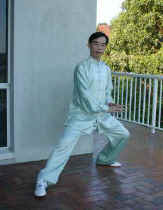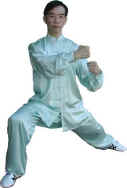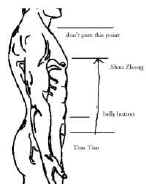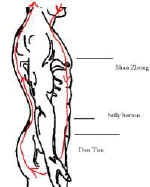Qi and Quan
© Copyrights Dr Paul Lam. All rights reserved, no part of this article may be reproduced in any forms or by any means, without permission in writing.
This article was originally published in the Qi-journal USA 2001.
Introduction
Qi has many meanings in Chinese; the most common one is air. In the context of Tai Chi it means the internal energy. Quan literally means a fist, when it is used after any name it becomes a martial art style. For example Tai Ji Quan (the pin yin spelling for Tai Chi); Ba Gua Quan and XingYi Quan, the later two are famous internal martial styles.
This article will discuss what are Qi and Quan, their connections and how to improve Qi to enable your Quan to reach a higher level.
What is Qi?
Qi is the life energy inside a person. This life energy comes from the combination of three things: the air breathed in through the lungs, essential Qi from the kidney and the Qi absorbed from food and water through the digestive system. Qi circulates throughout the body, performing many functions to maintain good health.
Like other internal martial art style, Qi is the driving force of the internal power (Jin) in Tai Chi. The mind (yi) directs the Qi, and the Qi drives the Jin, in practise, yi, Jin and Qi are inseparable. I will discuss this later.
Qigong, the exercise of Qi cultivation, is one of the oldest exercises in Chinese history. Its origin dates back more than one thousand years. There are numerous types of Qigong; generally speaking it is a variety of breathing, gymnastic, and meditative exercises.
Martial Art and Tai Chi Qigong
Qigong can be classified as Daoism; Buddhism, Confucius, martial art and other styles. In practical terms Qigong can be done sitting, standing or moving. There are hundreds and thousands of martial art styles in China, almost all of them have their own brand of Qigong. Generally speaking martial art style Qigong is moving, more practical and is part of the discipline. Although different style places varying degree of significance to its Qigong, internal style places greater significance in its Qigong. Most Tai Chi practitioners agree that Qigong is an integral part of Tai Chi.
Chinese culture, other martial arts, Buddhism and Confucius all have some influence in what Tai Chi is today, although it is well known that the Tai Chi Qigong derives from Dao Qigong. Tai Chi has also incorporated many Daoismís philosophical understanding of nature into its forms.
Forward Cannon Punch 1
Like other martial arts, Tai Chi Qigong is designed to serve the martial art purpose. Because of this cultivating Qi can be seen almost as background activity by some, especially comparing it to sitting meditative type of Qigong. This is not to say Qigong is not a vital part of Tai Chi, only it is almost hidden to untrained eyes. Unfortunately, some practitioners forget the Qi component in their forms.
Stationery and Moving Qigong
Most Tai Chi styles incorporated a set of
stationary Qigong, which usually involve standing and maintaining different
postures for varying periods of time. Like sitting meditative Qigong, it allows
you to concentrate better on the mind and the Qi without being distracted by
moving and coordinating the whole body. On the other hand, Qi is dynamic (it
circulates throughout the body) when practising Qigong, being in a stationery
position could create an imbalance between the inside and outside body. It is
accepted by many that if practise incorrectly, Qigong practitioners could be so
wrong-tracked that they become mentally disturbed in a very profound manner (the
literal translation of this term is: losing fire into the devil reign). People
are known to become crazy when their minds thus wrong-tracked. It is considered
to be the most dangerous risk of practising Qigong. This imbalance is believed
to be more likely to cause wrong tracking, whereas practising moving Tai Chi
Qigong has no such risk.
Forward Cannon Punch 2
What is Quan?
Quan is fist in Chinese, any name followed by Quan is a martial art style. Here I am going to use the word Quan to mean martial art. The ultimate purpose of Quan is to subdue or control your opponent. There are two types of Quan, ie the internal and external. Within either type there are many different styles. It is much harder to learn the internal Quan for effective self-defence. The external Quan use technique that is more natural to the body, stronger muscles, blocking and punching, the quicker and stronger tend to win. Whereas in internal art, one has to cultivate Qi (which may takes years
to reach a good level), integrates it to the body so it can be directed by the mind (yi) and able to drive internal power (jin) before it can be effectively use for self-defence. In a way it is like most things that takes more time and patience to cultivate initially, it usually ends up more powerful and last longer.Improve Qi to Better Quan
Strong Qi, not only making one healthier, it improves the level of Quan. I am going to confine this to Tai Chi, and to two important concepts because it is impossible to cover such a vast subject here. These are the understanding of Opening and Closing, and circulation of Qi.
1. Opening and Closing
Alternating opening and closing continuously is evident in any Tai Chi forms. Like drawing a bow to shoot an arrow, the drawing is storing energy that is opening. The shooting is releasing energy that is closing. This can be confusing, the opening and closing here relate to the use of Jin, not necessarily relate the outward appearance. For example in Yang style Single Whip, the end movement is a closing movement, not opening, its outward appearance is that of opening up.
As in all Qigong, correct breathing is of vital importance. Breathing in while drawing and breathing out while shooting. Chen Jin (one of the most famous Chen style master whose writing was responsible for making Chen style known outside the Chen village) said when opening your are solid outside and soft inside and when closing you should be soft outside and solid inside. For example, in the Chen style 36 Form, Form 34 Forward Cannon Punch, bringing both fists backward and downward to near the left hip (see picture one) is drawing the bow, then the punching with both fists (picture two) is shooting the arrow. Breathe in while storing energy, your outside is solid and inside soft; then breathes out when punching out with the outside soft (and elastic) and inside solid (Qi sinks to the Dan Tian). When breathing in Qi moves upwards and when breathing out Qi sinks downward.
Opening and closing is often described as stretching out and
relax, it is important to be aware that the muscles, ligaments and tendons can
be stretching out and yet this can happen when moving closer to the body. When
stretching out one must not over - stretched to the extent of becoming stiff,
otherwise the Qi will stop its flow. The converse is true in that when relaxing,
one must not collapse the muscles, ligaments and tendons; there should be a
certain amount of ward off force (peng jin) remaining otherwise Qi collapses and
the flow stops too.
Opening and Closing, breathe in and out in alternative pattern is the law of nature. All martial art styles follow this alternative pattern, although external styles tend to break the force, thus create a weakness. Tai Chi uses circular movement to facilitate the circulation of Qi, make the changing of energy smooth and continuous without a break. The internal energy become stronger as it flows continuously gathering more Qi, this is better illustrated by the next concept.
The breathing should be done with
mouth
gently close, tongue lightly touching the upper
palate, taking the Qi to the middle of the chest
(at the acupuncture point of Shan Zhong)
2. Circulation of Qi
A) The natural Qi from birth deteriorates as we grow older, Qi circulates and disburses over oneís head, chest or coccyx. So we continue to loose Qi as we grow. Qigong and Tai Chi help to retain and cultivate Qi. To many Tai Chiís goal is: "to live forever and to stay forever young", the key is Qi cultivation. To do this one needs to learn to be aware of Qi, and to direct it circulation consciously so that it can be retained and enhanced.
Once understood the opening and closing, the next stage is to move Qi upwards as you open or breathing in along the Conception vessel (a meridian or a Qi channel along the midline at the front of the body). The breathing should be done with mouth gently close, tongue lightly touching the upper palate, taking the Qi to the middle of the chest (at the acupuncture point of Shan Zhong, see picture 3) and definitely not higher than the throat, otherwise you will over strained and hinder the flow of Qi. As you breathe out, bring your Qi down to Dan Tian that is an area three-finger breadth below the belly button. You must take care to understanding which movement is opening and which is closing. At the beginning confine your practise to the forms that you are sure of which part being opening and closing. You must avoid forcing your breathing, if you run out of breath or not sure which way to go, then you should allow yourself to breath naturally. Usually when the body posture and the movement are correctly, the breathing will become right naturally.
Noted that at opening, loosening the hips and waist at the same time and turning in the hips and waist on closing.
 At
the out breathe Qi sinks down to
At
the out breathe Qi sinks down to
the Dan Tian, from the Dan Tian it
move up along the Governing vessel
on the in breathe, and then comes down
along the Conception vessel to moves in a circle.
B) After a suitable period when you can circulate the Qi in the above manner, this may take a long time. It depends on your health, talent, frequency of practiseÖ etc. Usually when your forms are well balanced, the flow of movement is even and strong, your postures being correct you will start feeling the abundance of Qi in the Dan Tian. You can then start working on circulating Qi. As you breathe in, feel Qi flows along the governing vessel (another meridian at the midline of back of the body) just underneath the skin and raises up to the scalp. At the out breathe Qi sinks down to the Dan Tian, from the Dan Tian it move up along the Governing vessel on the in breathe, and then comes down along the Conception vessel to moves in a circle. (see picture 4)
At this stage it may be difficult to reach without guidance of a good teacher and a lot of practise. There is a next stage when your Qi can be directed at will from Dan Tian, this is a difficult stage, best to be taught by teachers at a face to face setting.
Conclusion
I often read from articles and books that doing Tai Chi really well could rest on one certain vital aspect. I believe there are many essential principles that are important to reach higher level of Tai Chi. While it is difficult to define how high is oneís level, I donít believe anyone needs to be perfect to reach a high level. It is the understanding of these essential principles and diligent practise that will put almost anyone to a very high level. Knowing opening and closing, and circulation of Qi are two of these essential principles that help to improve skill.